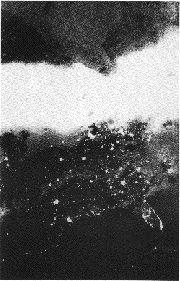|
Another effect of magnetic storms (and to lesser extent, of substorms) is a greater intensity of the electric currents circulating between Earth and distant space. As already noted, these currents are associated with the polar aurora, and they flow from space into the auroral zone or the other way around. In big storms, not only is the magnetic disturbance more intense, but it also spreads further equatorwards, into more densely populated areas. For instance, in the picture on the right, taken from space during a storm in March 1989, aurora blankets the northern states of the US as well as southern Canada

This disturbance also induces extra currents in the wires of the electrical power grid, creating a temporary overload. Serious overloads of this type can trigger circuit breakers and thus cause widespread "power blackouts," and on occasion they have even destroyed power transformers.
For these reasons, conditions at the Sun, in interplanetary space and in the magnetosphere are closely watched. The Space Environment Center in Boulder, Colorado, maintained by of the National Oceanic and Atmospheric Administration (NOAA), has a Space Weather Operation facility which constantly tracks the "weather" in space.
This is done in several ways. NOAA satellites of the GOES series, in synchronous orbit, observe the local radiation environment and also monitor the Sun's x-rays, which come from the corona and increase at active times. Telescopes on Earth observe the Sun through special filters and in special wavelength (e.g. x-rays), all of which highlight active features. For a view of NOAA's "space weather report," click here; another such report, from the University of Michigan, is linked here.
In an interesting development, the recent SOHO spacecraft, currently at the L1 Lagrangian point, allows scientists to detect (by special processing of its images) coronal mass ejections, not just in a sideways view but even when they are headed straight for Earth. A CME noted in this way on January 6, 1997, arrived as predicted on the 10th-11th and caused a widespread disturbance. Another such event occured April 7-11, 1997.
Of course, the sideways view of CMEs contains additional information, and NASA's planned solar missions include STEREO (Solar Terrestrial Relations Observatory), with a pair of well-separated solar observatories, to get a stereoscopic view of such eruptions. One spacecraft would orbit near Earth, the other would be stationed elsewhere in the Earth's orbit around the Sun, capturing a sideways view of solar eruptions. So far there is unfortunately no sure way of predicting whether the direction of the magnetic field carried by an erupting solar plasma would slant northwards or southwards, an important factor in predicting "space weather." Closer to Earth, spacecraft near the L1 point
such as SOHO and WIND, and since August 1997 also ACE, intercept shocks and plasma clouds up to one hour before their arrival at Earth and serve as early warning stations.
An obvious question is whether the high energy particles produced by such events constitute a hazard not just for spacecraft but also for astronauts. So far no astronauts have been seriously exposed, not even those on the Russian space station "Mir" whose inclined orbit extends to fairly high latitudes, closer to the auroral zone than the planned orbit of the International Space Station planned by NASA. Nothing in space can be guaranteed, however, and re-entry modules for quick escape into the protecting atmosphere have been studied.
Further Links and Articles:
A Canadian site on space weather and on the damage it can cause, http://www.spaceweather.gc.ca/effects_e.shtml.
An article about the violent consequences of the arrival at Earth of an interplanetary shock wave from the Sun, on 24 March 1991, titled
"The Birth of a Radiation Belt" (part of this site).
"Storms in Space: A Fictionalized Account of 'The Big One'," John W. Freeman, Jr., Eos, Transaction of American Geophysical Union 6 September, 1994.
"Geomagnetic Storm Forecasts and the Power Industry," by John G. Kappenman, Lawrence J. Zanetti and William A. Radasky,Eos, Transaction of American Geophysical Union 28 January, 1997.
Article "Geomagnetic Storms Can Threaten Electric Power Grid"
Questions from Users:
*** Why has the aurora been so frequent lately?
*** Does the magnetosphere affect weather? (a)
*** Risks from stormy "Space Weather"
***
Magnetic storms and headaches
*** Electric and Magnetic Energy
*** Radio Propagation
***
Magnetism and weather (b)
***
Waves in the Magnetosphere
|
